- Continue Shopping
- Your cart is empty
Glossary
A | B | C | D | E | F | G | H | I | J | K | L | M | N | O | P | Q | R | S | T | U | V | W | X | Y | Z
A
Acanthus: Plant whose foliage is one of the most widely used of all decorative motifs.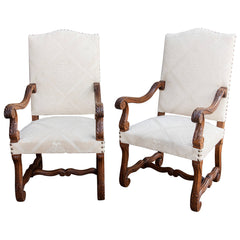
Alabaster: Finely granular variety of gypsum, often white and translucent used for ornamental objects such as sculptures and vases.
Andirons: Metal stands, usually of iron or brass, used for holding logs in a fireplace.
Antique: A work of art, a piece of furniture, or any other decorative object which, according to United States law, must be at least 100 years old.
Armoire: Wardrobe or large moveable cupboard with doors and shelves for storing clothing, originating in late 16th century France
Apothecary: Jars Small covered jars, formerly used by druggists to hold medicinal herbs.
Arabesque: Scroll of flowers and foliage arranged without concern for symmetry.
Art Deco: Period from 1925 to about 1935 when designers were influenced by simple geometric patterns.
Art Nouveau: Literally, "new art." Period from 1889 to 1925 associated with curvilinear swing design and inspired by plant and animal forms in nature frequently incorporating the figure of women.
Ash: A highly figured hardwood having a variety of shades from a grayish hue to deep brown.
Attributes: Symbolic objects, often used in the eighteenth century; palm fronds are an attribute of victory, rifles and game are attributes of the hunt.
Aubusson: A type of tapestry originally woven at Aubusson, France, a town in central France.
B
 Barbotine: Majolica. Earthenware having an opaque glaze of tin oxide and usually highly decorated.
Barbotine: Majolica. Earthenware having an opaque glaze of tin oxide and usually highly decorated.
Barley Twist: A turned furniture leg or column that resembles a screw thread.
Baroque: A style of architecture, art and decoration which originated in Italy during the late 16th century and spread throughout Europe. It is characterized by over scaled, bold details and sweeping curves.
Bassette: Literally, "low armoire"
Beech: A hardwood which lacks a pronounced grain.
Belle Époque: Period between 1871 and 1914 in France, characterized by marked advances and productivity in the arts, literature, and technology. Literally "the beautiful epoch."
Bergère: Armchair that is either caned or upholstered from the arm to the seat.
Bevel: The angle or edge that one surface makes with another when they are cut at a slant.
Bibliothèque: Literally, "library;" in furniture, bookcase.
Biedermeier: A style of furniture produced in Austria and Germany during the first half of the 19th century. Inspired by French Empire and German painted peasant work. The name was borrowed from an imaginary cartoon character called Papa Biedermeier, an uneducated country gentleman who considered himself a connoisseur of fine and industrial arts. Simple marquetry patterns were used with pressed brass ornaments of Greek inspiration as well as painted motifs of wreaths, urns and floral, animal and human forms. Woods used were mainly fruitwoods, maple, mahogany and birch.
Biscuit or Bisque: Unglazed porcelain that has been fired once, usually left entirely undecorated.
Bistro: A small modest European-style restaurant or café.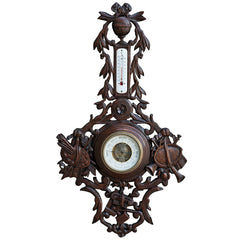 Black Forest: Furniture carved in and around Bern, Switzerland during the late 19th and early 20th centuries, commonly identified by its use of carved bears and other creatures of the forest, such as deer and birds.
Black Forest: Furniture carved in and around Bern, Switzerland during the late 19th and early 20th centuries, commonly identified by its use of carved bears and other creatures of the forest, such as deer and birds.
Bobèches: A glass ring placed at the base of a candle to gather wax or dangle crystals.
Boiserie: Sculptured paneling, especially that of French architecture in the 18th century.
Bombé: Literally, "blown out;" the front line of a piece of furniture which forms a convex, or belly-outward, curve
Book matching: Two adjacent sheets of veneer that are opened like a book and glued side by side to produce a symmetrical pattern.
Bonnet top: In cabinet work, a top with a broken pediment or arch, or a curved or scroll top with a central finial motif in the shape of a flame, urn, etc.
Bonnetière: Smaller armoire style cabinet that was used for storing woven goods.
Bois Doré: Ornamental coating of gold leaf or gold dust over wood.
Boulle work: Type of marquetry using tortoiseshell and metal, usually brass, introduced by André Charles Boulle in 18th century France.
Bow Front: A rounded curve on the front of a piece of wood furniture.
Brass: Metal alloy consisting mainly of copper and zinc.
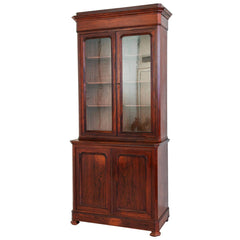 Bronze: Metal alloy consisting mainly of copper and tin, the tin content not exceeding 11 percent.
Bronze: Metal alloy consisting mainly of copper and tin, the tin content not exceeding 11 percent.
Bronze Doré: Ornamental coating of gold leaf or gold dust over bronze. Also known as gilding.
Buffet: Side- or serving-table used from medieval times.
Buffet Deux Corps: Literally, "buffet two bodies;" buffet with upper storage section that sits on top of the lower buffet.
Bun foot: Round, turned and sometimes "squashed" foot on a piece of furniture.
Bureau: Desk.
Bureau-plat: Flat writing-desk in the form of a large elongated table, often with two or three drawers underneath. Introduced at the end of the seventeenth century.
Burl: A tree knot or protruding growth that shows up as a pattern in the grain when sliced. Used for inlays and veneers.
C
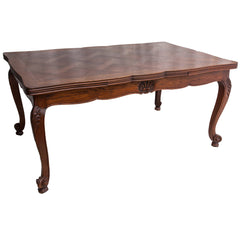 Cabriole leg: A furniture leg with a double curve. Popular in late 18th century and 19th century Europe.
Cabriole leg: A furniture leg with a double curve. Popular in late 18th century and 19th century Europe.
Cachepot: A French term used to identify a decorative china or metal jardinière designed to hold a small potted plant or cut flowers.
Cartouche: Escutcheon-like round or oval field, sometimes blank, sometimes inscribed surrounded by an elaborate frame.
Caryatid: Support shaped like a female figure.
Chaise fumeur: Literally, smoker's chair. A small chair for a man to straddle while resting his forearms on the chair back. Often had compartment for keeping tobacco and playing cards.
Chaise longue: Literally, "long chair." Also referred to as a fainting couch.
Chaise nourrice: Literally, "nursing chair." Country chair with low seat that was used while nursing babies near the fireside.
Chaise ponteuse: "Presentation chair." Small lady's chair used in the 19th century for receiving visitors.
Chauffeuse: "Fireside chair."
Chaumière: Thatched house often found in Normandy, France.
Chenets: Ornamental pieces placed in front of a fireplace.
Chinoiserie Chevet: Literally, "night stand." 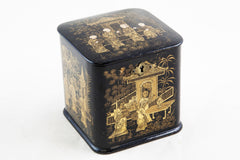 Chinoiserie: Style of ornamentation characterized by intricate patterns and an extensive use of Oriental motifs.
Chinoiserie: Style of ornamentation characterized by intricate patterns and an extensive use of Oriental motifs.
Choisy-le-Roi: A producer of French Majolica named for the town of Choisy-le-Roi.
Cloisonné: Enamelwork in which colored areas are separated by thin metal bands.
Coiffe: Lace headdress worn in the 19th century by women in Brittany and Normandy.
Coiffeuse: Small cabinet with lift-up top that was used for storing hair ornaments, brushes and combs.
Commode: Literally, "comfortable" or "convenient." Chest of drawers, a furniture type introduced toward the end of the 17th century.
Confident: S-shaped chair meant to seat two people facing in opposite directions. Used in the 18th and 19th centuries in the French salons for intimate conversations. Also referred to as a tête-à-tête, a French term with the literal meaning of "head-to-head."
Confiturier: Jam cabinet.
Console: Form of side-table supported by wall bracket(s) with two front legs.
Cornice: The top or finishing molding of a column or piece of furniture.
D

Demi-lune: Type of table in the shape of a half moon commonly placed against the wall.
Directoire: A period of design in France after the Revolution, from 1795 to 1804. Characterized by Roman motifs and named for the Directory, the French government during that period.
Dowel: Headless pin usually made of wood, used in furniture construction.
Drop-front: A top or front of a desk hinged at the bottom that drops to a horizontal position, forming a surface for writing.
Drop-leaf: Table built with hinged extension leaves, which lower when not in use.
Duchesse Brisée: Literally, "broken duchess." A set of two hand-carved armchairs and an ottoman or one hand-carved armchair and an ottoman in the Louis XV style that nest together to form a sort of chaise longue. Popular in 18th and 19th centuries.
E
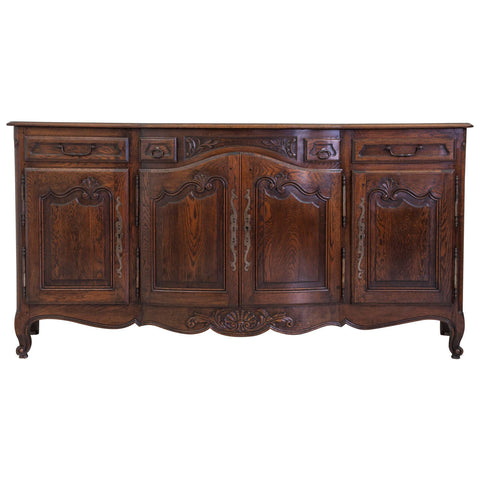 Ebéniste: Furniture-maker specializing in luxury case furniture incorporating marquetry of various kinds.
Ebéniste: Furniture-maker specializing in luxury case furniture incorporating marquetry of various kinds.
Empire: A period of Neo-classic design during the reign of Napoleon 1804-14. Greek, Roman and Egyptian motifs were widely used.
Enfilade Encoignure: Corner cupboard.
Enfilade: Literally from the French word "enfiler" meaning "to run along." A long buffet that runs down a long wall.
Engraving: Print from a copper or wooden plate upon which a drawing or design has been made by a metal tool.
Escutcheon: Metal plate fitted around a a keyhole for protection and decoration.
Estagnier: A Provencal shelf hung on the wall used for displaying plates. Often hung above a pétrin in a kitchen or dining area.
Etagère: Set of free-standing or wall shelves used to display objects.
Etching: See Engraving.
F
Faïence: Glazed earthenware such as Quimper Fauteuil: Open-armed chair with open sides.
Fauteuil: Open-armed chair with open sides.
Faux bamboo: Literally, "false bamboo."
Faux painting: Literally, "false painting." Painting technique intended to give the illusion that the surface is made of another material.
Finial: Decorative detail that is carved or shaped to ornament the top of an upright piece of furniture.
Fleur-de-lys: Heraldic bearing of the royal family of France. The iris flower or plant.
Fluting: Decoration formed by making parallel, concave grooves. In classical architecture they' re often seen on column shafts and run in a vertical direction.
French Provincial: Rustic versions of formal French furnishings of the 1600s and 1700s, such as the Louis XIV and Louis XV styles.
G
Gien: A French city known for its production of decorative faïence.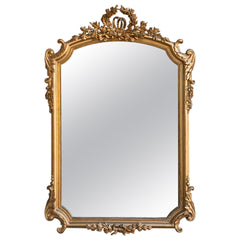
Gilding: Ornamental coating of gold leaf or gold dust.
Glaze: A vitreous coating fixed to ceramic by firing.
Glissant: Literally, "sliding." A term short for "buffet à glissant," a buffet with an upper and lower body whose upper body has doors that slide out to the sides. Typically, a Provençal piece.
Grillage: Aviary wire. Sometimes used to replace original panels in armoire doors.
Guéridon: A small table or pedestal with a circular top dating from the 17th and early 18th centuries. Originally used to support candelabras.
H
Hallmark: The mark or marks designating that a piece of metalwork has received an official approval of quality.
Henri II: Reigned in France between 1547 and 1559. Renaissance style of furniture during his reign underwent a revival in France in the 1890s referred to as Henri II style. Highly carved pieces include the buffet deux corps with its two superimposed units that often culminate in low pediments or cornices.
I
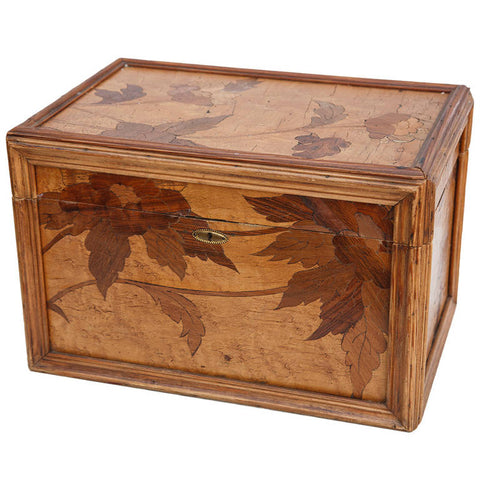 Icon: Portrait or image. In the Greek and Russian church it refers to the panels containing portraits or figures of sacred personages, as the Virgin and the various saints.
Icon: Portrait or image. In the Greek and Russian church it refers to the panels containing portraits or figures of sacred personages, as the Virgin and the various saints.
Incised: A pattern or carving produced by cutting into a stone, wood, or other hard surface. The reverse of relief carving.
Inlay: Form of decoration which involves cutting small pieces of ivory, precious metals, mother-of-pearl or wood which are then fitted into carved-out recesses of the same shape on a solid piece of furniture to create a picture or geometric design. This differs from marquetry which uses applied veneers, not whole pieces of wood.
Intaglio: Incised or sunken decoration.
Intarsia: Elaborate pictorial marquetry or inlaid paneling, used in Renaissance Italy and also 16th century Germany.
J
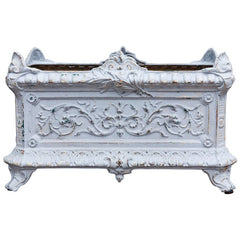
Jacquard: Type of weave done on a loom invented by Joseph Marie Jacquard in 1801, making possible a variety of intricate patterns. Damasks, brocades, and tapestries can be woven on jacquard looms.
Japanning: A process much used in the 18th century by which furniture and metalwork were enameled with colored shellac and the decoration raised and painted with gold and other colors.
Jardinière: Planter. A French term used to identify a decorative china or metal cachepot designed to hold a small potted plant or cut flowers.
Joinery: The craft of assembling woodwork by means of mortise and tenon dovetail, tongue-and-groove, dowels, etc.
K
L
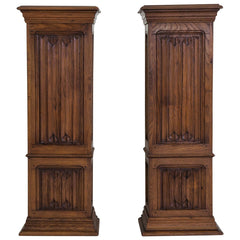 Lacquer: Oriental varnish obtained from the sap of the lacquer tree. Gave a high-gloss finish to furniture in Europe in the 17th century. Mother-of-pearl, coral and metals were often inlaid in the lacquer to create a decorative effect.
Lacquer: Oriental varnish obtained from the sap of the lacquer tree. Gave a high-gloss finish to furniture in Europe in the 17th century. Mother-of-pearl, coral and metals were often inlaid in the lacquer to create a decorative effect.Ladder back: A chair-back in which horizontal cross-rails give a ladder effect.
Lalique: A luminous, transparent glass introduced in the early 20th century by René Lalique of France. Most of his designs have a sculptural quality achieved by pressing and alternating a dull with a polished surface.
Lavabo: A washstand or washbowl, often with a fountain or water supply.
Linen fold: Form of carving, which imitated vertical folds of drapery. Probably Flemish in origin, it was widely used in the 15th and 16th centuries to decorate furniture and wall paneling.
Loupe: Burl.
Lithograph: A print made by putting writing or designs on stone with a greasy material, and producing printed impressions from this process.
Louis-Philippe: Reigned in France between 1830 and 1848. Louis-Philippe style furniture includes flat panels and a lack of moldings. Straight and smooth support posts are bare of ornament and their corners are rounded. Few decorative motifs.
Louis XIII: Reigned in France between 1610 and 1643. Renaissance style of furniture during his reign underwent a revival in France in the 1880s referred to as Louis XIII style. Highly carved pieces include the buffet deux corps with its two superimposed units that often culminate in low pediments or cornices. Barley twist is another frequent trait of the Louis XIII style.
Louis XIV: Known as the Sun King, he reigned in France between 1643 and 1715. Influenced the Baroque style in furniture during the earlier part of the reign, which later developed into the Regency style. Mahogany and oak were widely used. Baroque was large, masculine and symmetrical. Regency was characterized by its use of curves and introduction of chinoiserie. Ornamentation was usually done with rocks, shells, and flowers.
Louis XV: Reigned in France between 1715 and 1774. The style of furniture was essentially Rococo with soft flowing lines, shell and flower ornamentation, rich upholstery, inlaying and painted furniture.
Louis XVI: Reigned in France between 1774 and 1791. Characteristics of this style were rectangular lines, architectural ornamentation, classic symmetry, marquetry and the predominant use of mahogany.
M
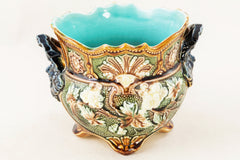
Maie: Chest with lift-up top that was used to store food in the French farmhouse.
Majolica: Pottery coated with a tin enamel and painted with bright colors. Originally an Italian and Spanish pottery, its French counterpart is called "barbotine."
Marquetry: A type of ornamental veneer comprising shaped pieces of wood or other substances which form a mosaic, or kind of jigsaw-puzzle, in floral, landscape, arabesque or other patterns; if a geometric pattern, called parquetry. It differs from inlay, in which a cut-out recess on a solid piece of furniture is filled with decoration.
Mortise-and-tenon: A hole cut in a piece of wood and intended to receive a tenon projecting from another piece of wood.
Mother-of-pearl: Iridescent white inlay composed of the highly polished pearly lining of certain seashells.
N
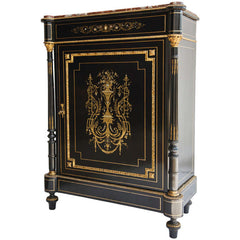 Napoléon III: Reigned in France from 1848 to 1870 during the period called the Second Empire. Characteristics of furniture produced during this period were borrowed from preceding styles. Use of dark woods including ebony. Imitation of Boulle marquetry. Widespread production of papier-mâché accessories often inset with mother of pearl.
Napoléon III: Reigned in France from 1848 to 1870 during the period called the Second Empire. Characteristics of furniture produced during this period were borrowed from preceding styles. Use of dark woods including ebony. Imitation of Boulle marquetry. Widespread production of papier-mâché accessories often inset with mother of pearl.
Neo-classic: Refers to the second revival of classic design for interior decoration in the 18th century.
Nesting tables Group of tables, usually three, constructed so that one fits under the other.
Niche A recessed or hollow space in a wall, intended to hold a statue or ornament.
O
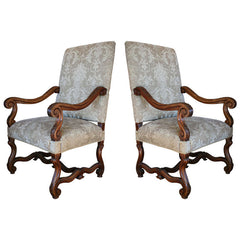 Obelisk: Tall, square stone monumental shaft with pyramidal top used in ancient Egypt. The form, on a small scale in alabaster, is used as a decorative ornament in Directoire, Empire and contemporary interiors.
Obelisk: Tall, square stone monumental shaft with pyramidal top used in ancient Egypt. The form, on a small scale in alabaster, is used as a decorative ornament in Directoire, Empire and contemporary interiors.
Ormolu: French term for a type of cast bronze ornament finished by hand chasing and surfaced with gold. Also known as gilt-bronze or bronze doré. Often used to refer to bronze furniture mounts enhanced by gilding.
Os de mouton: Literally, "mutton bone." Refers to the sinuous stretchers in Louis XIV furniture.
P
 Palmette: Fan-shaped pattern derived from the shape of a palm frond. Neo-classical motif.
Palmette: Fan-shaped pattern derived from the shape of a palm frond. Neo-classical motif.
Panetière: Provençal piece of furniture, originally from Arles, that was used to store bread. Was hung on the wall or placed on top of a pétrin. Has turned spindles, hand carved ornamentation, and finials.
Papier-mâché: Technique using sand, chalk, and paper pulp molded while wet into decorative forms and furniture. Popular during the Napoléon III period.
Paravent: Folding screen.
Parquetry: Inlay of geometric design.
Partner's desk: Desk large enough to set two people facing each other with working drawers on both sides.
Patina: Term used to designate a mellow sheen formed n the surface of furniture, due to wear, age, exposure and hand-rubbing. Also a film, usually greenish, formed on copper or bronze after long exposure.
Petit-point: Small-stitch embroidery, which is worked on a single thread net, covering the entire surface. Term usually applies when there are more than 256 stitches to the square inch.
Pétrin: coffer type piece of furniture on four legs with top that lifts up or off. Was used to store flour or to put dough inside to rise. 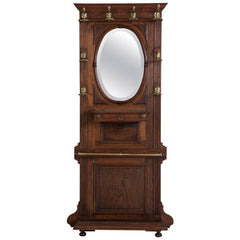
Poinçon: Punched silver hallmarks on French silver.
Poplar: Even-textured and straight-grained wood, it is available in lumber as well as in thin stock suitable for cross-banding and face veneers.
Porcelain: A hard, non-porous pottery. True porcelain is made of kaolin or china clay.
Portemanteau: Literally, "holds coats." Coat and hat rack or hall tree.
Porte-parapluies: Literally, "holds umbrellas." Umbrella stand.
Pot de confit: Literally, confit pot. Glazed earthenware pot used to store goose meat in fat for preparing a goose confit.
Prie-dieu: Literally, "prays God." A low-seated armless chair with a high back and wide top-rail on which to rest a prayer book. Used as a kneeler for prayer.
Q
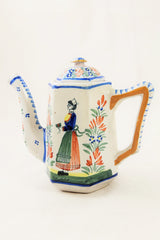 Quimper: Tin-glazed earthenware, or faïence, that is hand-painted with scenes depicting life in the province of Brittany, France.
Quimper: Tin-glazed earthenware, or faïence, that is hand-painted with scenes depicting life in the province of Brittany, France.
R
Rattan: A climbing palm, remarkable for the great length attained by its stems. Commonly used for wickerwork, seats of chairs, walking sticks, etc.
Refectory table: A long and narrow table having stretchers close to the floor. These were used in monasteries for the monks to take their meals while seated on one side only of the table. American antique dealers often refer to the French draw leaf table as a refectory table as well.
Regency: Transitional period in French furniture design between Louis XIV and the Rococo style developed by Louis XV. Named for the time frame in France from 1715 to 1728 when Philip, Duke of Orleans, reigned. Characteristics are graceful curves, the cabriole leg, and ornamentation copied from nature rather than mythology. Bright veneers of rosewood and satinwood were widely used.
Régule: Tin-rich alloy usually containing some antimony, some copper, and sometimes some lead. Used in the 19th century to cast figures that were finished with a bronze coating to resemble their more expensive counterparts cast of solid bronze.
Relief: Forms of molded, carved or stamped decoration raised from the surface of a piece of furniture forming a pattern.
Repoussé: Literally, "pushed out." A term for the method of making a design in relief in metalwork, commonly brass, by hammering from behind so that the decoration projects outward.
Restoration: Period in Neo-classic design between the years of 1815 and 1830 under Louis XVIII (1815-23) and Charles X (1823-30). Similar to Empire style but with smaller dimensions and more restrained ornamentation.
Rocaille: Rococo form of decoration using abstract shell- and rockwork in its design.
Rococo: Period in French design originating in the 18th century after Baroque. It was asymmetrical and tended to be over-ornamented. Name is derived from the French words rocaille and coquille, rock and shell, which are prominent motifs in this decoration.
Rosette: Ornamental motif in the shape of a star or rose.
Rush seat: A woven seat where either natural cattail leaf rush, bulrush or man-made paper fiber rush is woven around the four seat rungs or dowels, forming four distinct triangles in the seat pattern.
S
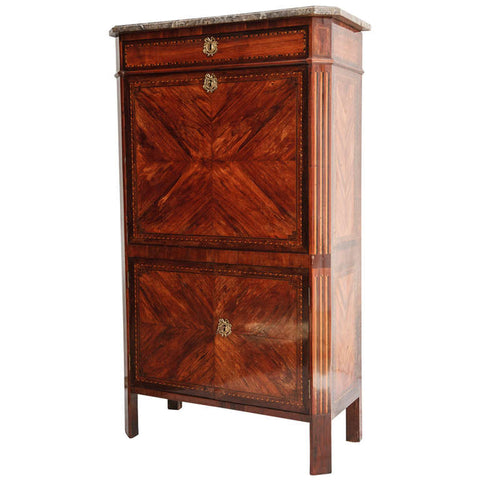 Sabot: metal "shoe," protective as well as ornamental, on the feet of a piece of furniture.
Sabot: metal "shoe," protective as well as ornamental, on the feet of a piece of furniture.
Samovar: An urn with a spigot at its base used especially in Russia to boil water for tea.
Sarreguemines: A French faience that produced Majolica
Sconce: A lighting fixture with one or more branches that is attached to a wall.
Secretary desk: An 18th century tall piece of furniture with drawers at the bottom, a bookcase on top and a desk with a drop-lid in the center.
Staffordshire pottery: Pottery made in Staffordshire, England. Provincial in shape, ornamentation and coloring. The better grades are usually known by the individual names of their makers.
Sterling: A term used in connection with silverware, indicating that the silver is 92.5 percent pure.
Stretcher: Strengthening or stabilizing rail, which runs horizontally between furniture legs, often forming X, H, or Y shapes.
T
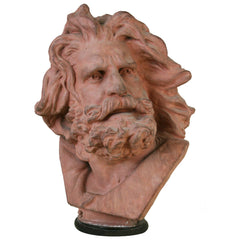 Terra cotta: Hard-baked pottery used in decorative arts and as a building material, usually of a red-brown clay, but may be colored with paint or baked glaze.
Terra cotta: Hard-baked pottery used in decorative arts and as a building material, usually of a red-brown clay, but may be colored with paint or baked glaze.
Terre de fer: Faïence or earthenware with iron content.
Tête-à-tête: See confident.
Thonet: Bentwood furniture produced by a steam process developed by the German cabinetmaker Michael Thonet in 1835. The Thonet line is best known for its graceful curvilinear Art Nouveau designs produced at the turn of the nineteenth century and for its highly sophisticated Art Deco designs of the 1920s.
Tilt-top table: Table with whole top hinged to a pedestal base so that it can be tipped from a horizontal to a vertical position when not in use.
Tole: Tin., Tinware that is usually decorated by means of japanning.
Tongue-and-groove: Straight or right-angled joint made by cutting a groove into one piece of wood into which fits the projecting groove from another. Used from the 19th century onwards.
Torchère: Type of floor lamp equipped with a decorative glass or metal reflector bowl designed to throw light upward. 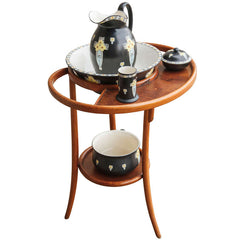 Trestle table: Table composed of a long, oblong board, originally supported by a trestle or sawhorse, but now supported by posts and feet.
Trestle table: Table composed of a long, oblong board, originally supported by a trestle or sawhorse, but now supported by posts and feet.
Trompe l'oeil: Idiomatic French term meaning literally "tricks the eye." A type of decoration borrowed by the French from the Greeks during the 17th century. Objects painted in perspective to suggest they are three-dimensional.
Trumeau: The decorative treatment of the space over a mantel, door, or window consisting of a mirror or painting. Specifically, the over mantel panel treatment of the Louis XV and Louis XVI periods.
Turning: Decoration produced by rotating or turning wood on a lathe and cutting it to form twisted or bulbous designs. All periods have employed turning, especially on the legs of tables. The design of the turning is often the key to the period to which the furniture belongs.
U
V
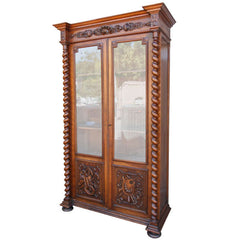 Vaisselier: A hutch or china cabinet. A buffet deux corps used to store dishes. Comes from the French word "vaisselle" meaning dishes.
Vaisselier: A hutch or china cabinet. A buffet deux corps used to store dishes. Comes from the French word "vaisselle" meaning dishes.
Veneer: Decorative effect accomplished by the application of thin layers of ornamental and often exotic woods to an underlying structurally supporting surface.
Vitrine: French term for a display cabinet with a glass front. Comes from the French word "vitre," meaning a glass pane.
W
X
Y
Z
Sources:
Chadenet, Sylvie. Tous les Styles du Louis XIII a l'Art Deco. Paris: Sofédis, 1981.
Parvulesco, Constantin. Guide des Meubles Régionaux. Paris: Flammarion, 2001.
Kylloe, Ralph. Rustic Traditions. Utah: Gibbs Smith, 1993.
Newman, Bruse M. Fantasy Furniture. New York: Rizzoli, 1989.
Parker, Clifford. Initiation à la Culture Française. New York: Harper and Row, 1963.
Payne, Christopher. Sotheby's Concise Encyclopedia of Furniture. New York: Harper and Row, 1989.




